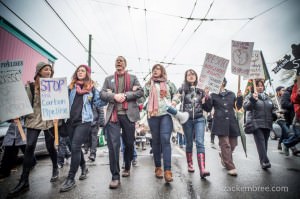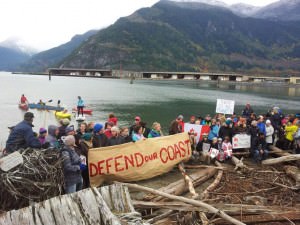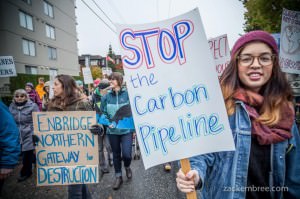Warrior Up: Thousands Protest Northern Gateway Pipeline in Victoria
What the Northern Gateway Pipeline project does to B.C. and the protestors
By Megan Gartrell, Staff Writer
The Northern Gateway pipeline project is no stranger to controversy, and on October 22, 2012 thousands of protestors gathered on the lawn of Victoria B.C.’s legislative building to send a clear message to Prime Minister Stephen Harper and B.C. Premier Christy Clark: “Our coast is not for sale.”
Greenpeace International co-founder, Rex Weyler informed me via email, “I was pleased [with the turnout.]”
“The crowd was flowing in and out all day, so it is difficult to estimate numbers, but it seemed to me, at its peak, about 4000,” he said. “The ferry from Vancouver had to cut off foot-passengers. Even more impressive were both the diversity of the crowd and the coalition of First Nations, unions, environmental groups, and general public. The event felt like a great wave of public interest to protect the B.C. marine environments and our coastal economies.”
Despite chill winds and rain there was an undeniably positive energy. Raised high were banners proclaiming: “There is no Planet B,” and “People speak louder than money.” Amongst the pulse of native drums, many faces had the eerie appearance of weeping oil after being painted with black tears. During the First Nations procession march, men and women donned in traditional regalia carried a massive paper salmon of red and green mounted on sticks up the stairs of Parliament and pressed the salmon’s mouth to the doors.
Many Canadians believe this is a tipping point – a moment in history when the public has the responsibility and opportunity to re-envision the world. Chief Karen Ogen of the Wet’suwet’en First Nation, one of many to step up to the microphone, said, “this decision over whether the pipeline is built will be made by the will of the people.”
The rally was organized by the Defend our Coast coalition, which is made up of various environmental groups and First Nations communities. In attendance were representatives from the Wilderness Committee, Tanker Free BC, Greenpeace International, and Forest Ethics; Chiefs from Coastal First Nations; and unions such as the Communications, Energy and Paperworks Union of Canada; CUPE; and the BC Teachers Federation. The day began with many prominent speakers and performers and the crowd responded in unison: “We are with you.”
During his moving speech, Chief Rueben George of the Tsleil Waututh First Nation said:
It is apparent from the size of this crowd that we are winning. When we come together our spirits collide and we become stronger. We cannot put a price on our air, our water, and our land. We say no. We want to make a difference for our children and our children’s children. The owners of Enbridge and Kinder Morgan are too blind by greed to see, so we are going to do it for their children too. Be a pebble thrown in the pond and ripple out our message.
Chief Martin Louieof the Nadleh Whut’en First Nation said, “We are not selling our future for any amount of money. It’s time to warrior up.”
Many of the protestors attended training the Sunday prior to the protest in anticipation of civil disobedience that could result in arrest. The first wave of action was a visual message to Harper and Clark. Protestors willing to risk arrest pounded into the ground a 235-metre long black cloth banner. The length represented how long an oil tanker is and the colour symbolic of death and oil. The banner stretched across the lawn and blockaded Wharf Street. But despite the fact it is illegal to drive anything into the Parliament lawn, no arrests were made.
But that does not mean protestors are not prepared to “warrior up.” Weyler explained:
We’ll go all the way, to arrests, blockades, and beyond. The only concession in the battle to save our coast, save the Earth from global heating, and restore ecological balance would be to initiate a national energy policy that provides a transition from our current fossil fuel economy and resource plunder economy to a renewable energy and resource preservation economy. We have been asking for this dialogue for decades.
Environmentalists say the government must move away from carbon fuels and focus on clean energy.
The Northern Gateway Pipeline
As Enbridge’s website explains, The Northern Gateway Pipeline is a proposal to construct twin petroleum pipelines along the 1,170 kilometres between Brudenheim (located just north of the city of Edmonton) and Kitimat, B.C. One pipeline would carry 525,000 barrels per day of Alberta tar sands crude oil to a new oil tanker port at Kitimat. The other would carry condensate – a lighter petroleum product used to dilute bitumen –for use in transporting the tar sands crude oil.
Opponents of the project fear the environmental impact of a pipeline leak or the damage to the coastline from a tanker spill. For most of the protestors at the rally it is not a question of if there will be a spill but when. One of the issues raised was the route. If constructed, the Northern Gateway pipeline must cross the rugged, mountainous terrain of the Northern Rockies and the Coastal Mountains of B.C. Metal pipelines age and corrode over time, making them susceptible to ruptures. Pipelines are at risk of breakage due to natural events such as landslides or rockslides both of which pose dangers in this proposed route.
Another issue regarding the proposed route is the some 1,000 streams and rivers the pipeline would cross, including the sensitive salmon-spawning habitat in the upper Fraser, Skeena, and Kitimat watersheds.
It would also cross the territories of more than 50 First Nations groups. Defend our Coast’s website currently states that the Northern Gateway Pipeline is opposed by nine of the Coastal First Nations as well as many of the island First Nations along the pipeline route. In March 2010, the Coastal First Nations signed the Fraser River Declaration stating that, “tar sands oil will not be allowed to transit our traditional lands and waters.”
A Joint Review Panel (J.R.P.) led by the National Energy Board and Canadian Environmental Agency will review Enbridge’s proposed Northern Gateway Project. The J.R.P. is a quasi-judicial process that will involve hearings in communities along the pipeline route and on the B.C. coast. The three panel members – Sheila Leggett, Hans Matthews and Kenneth Bateman – have until the end of the year to complete a report.
When asked if he felt the panel fairly represents the needs of the First Nations communities, Weyler answered:
No. The system is designed and operated to bias the decisions in favor of industry. The tar sands itself may be the most destructive single industrial enterprise in the history of human civilization, and the carbon alone in the tar sands, if exploited and released, will send Earth’s atmosphere into runaway global heating, so a fair environmental review would not remotely approve the pipelines that will allow this crisis to unfold. Clearly the First Nations have not been fairly heard, since both the Yinka Dene Alliance, Coastal First Nations, and individual First Nations – totaling some 161 Nations – have signed or supported the Fraser River Declaration. This alone should end the discussion. The First Nations have clearly spoken as a unified voice.
Benefits to B.C.
As their website states, Enbridge’s reasons for the pipeline are to facilitate access to new markets for Canadian tar sands oil. Currently, the majority of tar sands oil is shipped south to U.S. markets. Enbridge explains 3,000 jobs will be created for B.C. during the construction phase as well as 60 long-term employment opportunities.
The project, according to Enbridge, will create a lasting legacy of local investment, tax revenue, and jobs for the North, over and above the tremendous benefits created by access to new and growing markets for Canadian natural resources.
Enbridge is also offering Aboriginal people a 10% share in a $5.5 billion dollar project. That is about $280 million in net income over the next 30 years. Enbridge maintains the $6 billion pipeline will bring in $81 billion in revenue over three decades.
But Enbridge has not been oblivious to the response of the public. In a recent Vancouver Sun article, Enbridge explained it plans to launch a multimillion-dollar advertising campaign in British Columbia in response to the stiff opposition.
“You are going to see a much higher visibility for Enbridge over the next few days. In newspapers, in television and online,” said Paul Stanway, manager of Northern Gateway communications for Enbridge. “It’s become quite apparent that the debate has become a province-wide issue.”
The ad campaign’s purpose is to direct people to the project’s website, www.northerngateway.ca, where the company has posted information and blogs on topics from economic benefits to environmental safeguards. The campaign is to begin this week with full-page ads in major B.C. daily newspapers and 30-second television ads with the slogan: “It’s more than a pipeline. It’s a path to our future.”
Enbridge Rally Not Yet Out of Fuel
If anything the increase of media coverage for both sides, those for and against the Northern Gateway pipeline project and the Kinder Morgan pipeline expansion project, will give citizens the opportunity to learn more.
For those wanting to aid the province and coast fight pipeline expansion, Weyler has some advice:
First off: inform one’s self. Learn about the impact of carbon in the atmosphere and oceans. Learn about the frequency and devastation of oil spills in all pipelines and oil ports. Learn about renewable energy. Secondly: practice conservation. Buy less stuff, use less energy, and learn to live better lives by living more simply. Also, support the groups who are fighting this battle every day: The Wilderness Committee, Tanker Free BC, Greenpeace, and others. Support the First Nations. And finally, speak out in one’s own community, in newspapers, on radio, in public meetings, in schools. Let one’s voice be heard.
The protest in Victoria is not the final chapter for the Defend our Coast coalition. Organizers hope this will help gain the momentum needed to force politicians and rule-makers to listen. They are vowing to keep up the pressure until the pipeline plans are scrapped.
The next step was another day of action on Wednesday October 24, 2012. More than 60 anti-pipeline demonstrations at MLA’s headquarters of both the Liberal and NDP parties have thus far taken place across the province. And a group of more than 100 marched from UBC to Christy Clark’s West Point Grey constituency office.
Along with the desire to stop Enbridge from building the proposed Northern Gateway Pipeline was the cry to stop the doubling of Kinder Morgan’s Trans Mountain pipeline, which stretches 1,150 kilometres between Edmonton and terminals in the Vancouver area and Washington State. It carries heavy and light crude oil, as well as refined products such as gasoline and diesel.
The day of action was widespread: from Kelowna to Kamloops to Fort St. James and Bella Bella, British Columbians came out in droves to remind their politicians who they are elected to represent.
Back in Victoria, the banner has been taken down and the Legislative building’s front lawn picturesqueness has resumed. But if anything has resonated from the day of action, it is the people’s collective voice as well as the fact that the Northern Gateway pipeline project and other pipeline expansions are not issues Canadians are willing to stay quiet over.
List of Sources:
Northern Gateway
Defend Our Coast
Vancouver Sun
Wikipedia
Facebook page: Defend Our Coast
Interview with Rex Weyler October 23, 2012.
—————————————-
Liked this article? Hated it? Comment below and share your opinions with other ARB readers!



























Share the post "Warrior Up: Thousands Protest Northern Gateway Pipeline in Victoria"